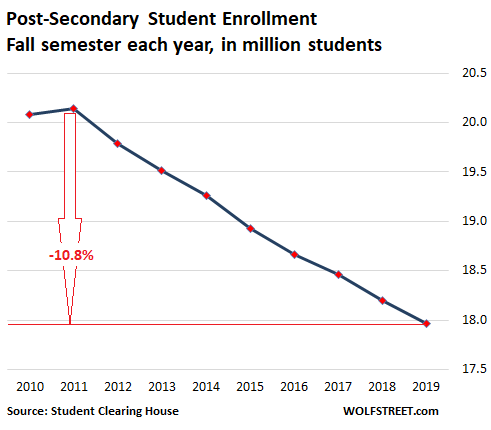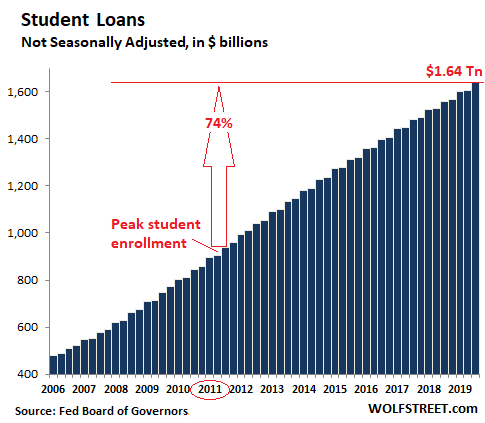The Daily Escape:

Cathedral Rock at sunset, Sedona AZ – 2019 photo by microadventures
The Student Clearing House reports that the college student headcount of undergraduate and graduate students combined fell by 1.3% in the fall semester of 2019 over the same semester last year. That equals 231,000 fewer students compared to 2018.
This is the continuation of a long decline. The peak year was the fall semester of 2011, when 20.14 million students were enrolled. Since then, enrollment has dropped by 10.8%, or by 2.17 million students. Here’s a helpful graph by Wolf Richter:

The report covers 97% of enrollments at degree-granting post secondary institutions that are eligible to receive federal financial aid. It does not include international students, who account for just under 5% of total student enrollment in the US.
Women by far outnumbered men in total enrollment in the fall semester of 2019 with 10.63 million women enrolled, compared to 7.61 million men, meaning that overall there are now 40% more women in college than men.
Inside Higher Ed reports that community college enrollments declined by 3.4%. Four-year public institutions saw a drop of 0.9%. Four-year private institutions bucked the trend with an increase of 3.2%. However, the Student Clearing House said most of this increase was due to the conversion of large for-profit institutions to nonprofit status. Grand Canyon University, for example, successfully made the transition last year.
Wolf Richter says that the 10.8% decline in enrollment since 2011 comes even as student loan balances have surged 74% over the same period, from $940 billion to $1.64 trillion:

Looking at the two charts, it’s clear that over the last eight years, enrollment has declined in a straight line at about 1.35% per year. And over the same eight years, student loan debt has increased in a straight line at nearly $90 billion per year!
We’re seeing three trends: First, the decline in enrollments. Second the decline in men attending college. Third, the soaring costs of college leading to soaring student debt.
No one has the answers to all three, but the decline in enrollments may have a demographic element. We are approaching the tail end of the college-aged millennial generation. Higher education has been facing demographic headwinds for a decade. The post-millennial generation is simply smaller than the previous generation.
Meanwhile, a big part of the enrollment peak spike in 2009-2012 period was due to people choosing education to avoid unemployment during the Great Recession. And 25% of the enrollment decline is due to the for-profit diploma mills losing their government support after years of robbing their “students” blind.
The rapidly increasing costs of college are a burden that can also drive down enrollments. The numbers do not favor investing in a college degree as much as they used to. Back in the day, a good entry level job’s salary was about 4 times the annual tuition. Now it’s under 2 times. If you check out some of the terrible numbers for 20-year net Return on Investment (ROI) on payscale.com, it’s clear that many colleges and universities have negative or relatively small ROIs.
OTOH, there’s still a massive income gap between people with a college degree and those without one. And outside of a few small business owners, there’s no way around it. College is the only reliable way to get into the middle class, and stay there.
The college industrial complex knows that it has a stranglehold on your future, and it will try to suck as much money out of you as possible.
The solutions involve some of the things that Sanders, Warren and others are talking about. Wrongo is for making college free for all. He isn’t for debt forgiveness, but for granting interest-free loans to students. Those loans should be carried only by the federal government.
Cost containment is the biggest issue. Online education is now readily available, and saves on both tuition and room and board. The economy is stronger, so on-the-job training is returning, and a lot of specific how-to knowledge is now available online.
Except for the male-female imbalance, much of this is solvable.
Finally, higher education serves many purposes in our society. As a people, we need it for its practical value, but also for sharpening our ideals, nurturing our growth, advancing our knowledge, and our arts.
Despite a popular subculture of anti-intellectualism and doubt, we should still know that a people without ideals are lost.
